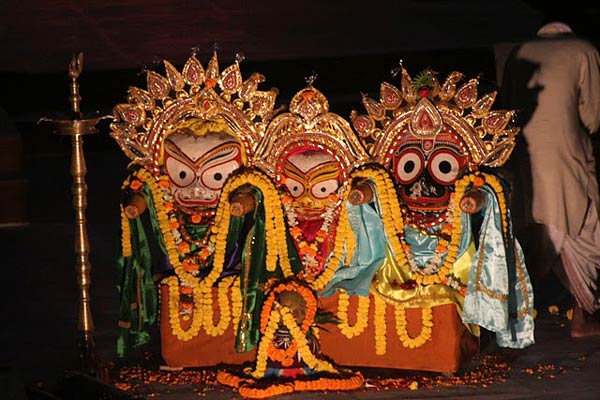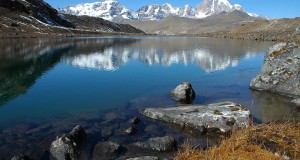Puri is one of the four holiest Hindu cities in India, also an upcoming beach resort. It’s a remarkable place, packed with atmosphere and pilgrims, which comes as close to ‘real’ India as you can expect. The religious and cultural life of the small, busy town centres round the huge 12th-century Jagannath Temple, home of the ‘Formless God’, Lord Jagannath, 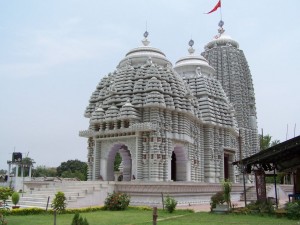 who is said to represent the primordial essence of the universe. At the spectacular Rath Yatra (Car Festival) of June–July, Puri is invaded by zealous armies of pilgrims who gather from all over India to worship the images of Jagannath, as they are dragged through town on massive wooden chariots. It’s the most intense demonstration of religious fervour anywhere, an impossible madhouse of swaying crowds, but apparently great fun.
who is said to represent the primordial essence of the universe. At the spectacular Rath Yatra (Car Festival) of June–July, Puri is invaded by zealous armies of pilgrims who gather from all over India to worship the images of Jagannath, as they are dragged through town on massive wooden chariots. It’s the most intense demonstration of religious fervour anywhere, an impossible madhouse of swaying crowds, but apparently great fun.
The ride out by OTDC coach to Puri is beautiful in spring—mile upon mile of lush, green paddy fields and violet water-hyacinths, interspersed with temples, semitropical jungles and lively farming villages.
Some 20 km (125 miles) out of Bhubaneshwar, you’ll visit the small village of Pipli, internationally famous for its bright, colourful applique art and handicrafts. Here intricate mirror-inlaid tapestries are produced, and vivid prayer-flags and beachumbrellas, saris and bedsheets, wall and table covers, canopies and lamp shades—all brilliantly coloured and often employing decorative motifs of birds, animals, flowers or leaves. Unfortunately, Pipli itself is not a good place to buy this produce. Most of its quality crafts are sent to Bhubaneshwar for sale. What remains, in grubby roadside shops and emporia, is largely substandard stuff. Ask to be directed to the houses of one of the few elderly artists who still remember how to make the delicate, elaborate stalls deal furiously in cold drinks, silverware, vegetarian food and all L manner of cheap religio-tounist paraphernalia. All along the dusty thoroughfare, temple bells clang an insistent invitation to devotees.
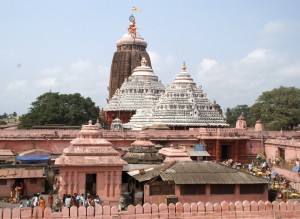 The Jagannath Temple, built during the 12th century by the Kalinga ruler Chodaganga Deva, is the tallest and most magnificent monument in Orissa. Its pinnacle rises to a formidable height of 65 m (212 ft), and dominates the skyline for miles around. It is divided into four parts: the central main hall, the hall of audience, the dancing hall and the hall of offerings, and has four gates. Each of these has an animal theme: horse (south gate), elephant (north gate), tiger (west gate) and the lion (east gate). It is by the lion gate that pilgrims make their entrance, to visit Lord Jagannath and commune with his qualities of light, power and wisdom. In front of this main gate stands a 16-sided monolithic pillar called Aruna Stambha, which used to stand in front of Konarak’s Sun Temple until brought here in the 18th century.
The Jagannath Temple, built during the 12th century by the Kalinga ruler Chodaganga Deva, is the tallest and most magnificent monument in Orissa. Its pinnacle rises to a formidable height of 65 m (212 ft), and dominates the skyline for miles around. It is divided into four parts: the central main hall, the hall of audience, the dancing hall and the hall of offerings, and has four gates. Each of these has an animal theme: horse (south gate), elephant (north gate), tiger (west gate) and the lion (east gate). It is by the lion gate that pilgrims make their entrance, to visit Lord Jagannath and commune with his qualities of light, power and wisdom. In front of this main gate stands a 16-sided monolithic pillar called Aruna Stambha, which used to stand in front of Konarak’s Sun Temple until brought here in the 18th century.
Non-Hindus aren’t allowed into the Jagannath temple, but you can peer over the walls from a nearby viewing platform. This is located on the roof of the Raghunandan Library, opposite the Lion Gate. As you climb the stairs within, you are shown a sign reading ‘Be Aware of Monkeys’ and are given a big stick. From the open roof, you can marvel at the sheer power and majesty of this huge temple, which rather resembles a primitive spaceship. You also have a clear sweep of Puri town, the main street a veritable gauntlet of beggars and mendicants, ganja-sellers and hawkers, bullock carts and itinerant cows; scores of dazed Indian families weave a crazy, erratic path from tour bus to temple. Off the roof, stop in at the library’s first-floor museum which has an 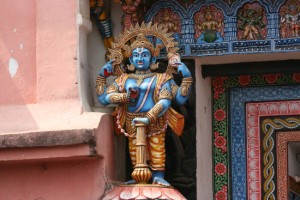 interesting collection of rare palm-leaf manuscripts, some dating back 350 years. Many are written in ancient Sanskrit, scratched out by quill-pen, and beautifully coloured. The curator is keen to show you samples. He is even keener to sell you some copies.
interesting collection of rare palm-leaf manuscripts, some dating back 350 years. Many are written in ancient Sanskrit, scratched out by quill-pen, and beautifully coloured. The curator is keen to show you samples. He is even keener to sell you some copies.
Walking round the temple perimeter is interesting. You can see some of the original fine carvings on the exterior walls, buried until recently under a thick coat of lime plaster, but now being revealed as the result of patient conservation work. Note especially the four temple gates. These all have an animal theme— notably the main gate, with its portal pair of moustachioed lions. By the gates are the temple money-changers. Their job is to take Rsl coins from visiting pilgrims, returning them 90 paise in small coins (for distribution to beggars within) and keeping the remaining 10 paise as commission. Many travellers use their services too: they are apparently the only people in India with a ready supply of small change.
The tour moves on to nearby Puri Beach for a pleasant thali lunch at the tourist bungalow. Afterwards, there’s time for a walk along the long, sandy beach or a swim. The sea is rather brisk and very salty. You can shower off in the tourist bungalow afterwards but nothing deters pilgrims from their dip in the holy waters. If you decide to join them, be prepared to be adopted by local fishermen, who lassoo hesitant bathers with rubber rings. It’s okay to change on the beach, leaving your togs with an Indian family, or pay a boy a rupee to mind them for you.

